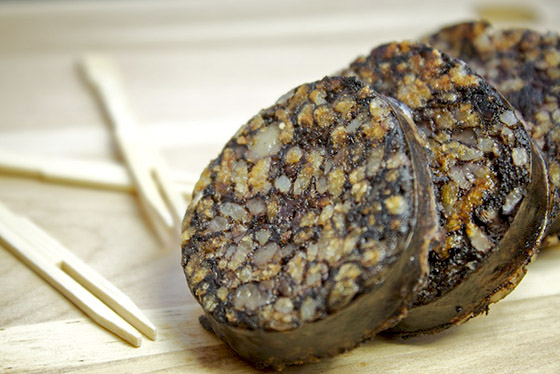Certainly, there is no accounting for taste, not even when it comes to blood sausage. The question is whether there could be some orange in any black pudding? Or possibly some pine nuts? Can we drink champagne with that at all? All these intriguing and interesting questions. Let’s see the answers.
We might not be going too far if we say that in Central Europe blood sausage is a part of life. Similarly to the unquestionable ground red paprika, lard-spreaded bread, fermented cucumber and sausage, black and white pudding are consumed as a rule. Some like the black version with rice, while others eat cold, fried liver sausage with potatoes and bread, pickles or mustard. Just for fun, let’s get out of our comfort zone a bit and try to put a whole menu of blood sausages together with matching wines.

Blood sausage for breakfast?
The British wouldn’t say ‘no’ to this. Surely, one from the Continent can never know what those strange folks living on an island are doing… I’m just joking, of course. However, when in a British hotel we are offered black pudding for breakfast, it is better not to expect any chocolate. The famous British blood sausage is great food no matter if it is served as cold slices or fried in oil. It is typically mildly seasoned, served traditionally with a lot of baked beans, bacon, fried eggs and potato but a creative version could include some green salad and a pinch of smoked salt. Add some good champagne to come up with an updated English breakfast.
Sausage Odyssey
Who else could have first written about blood sausage if not Homer? As he put it, sausage was filled with fat and blood only but Ancient Roman cuisine improved the Greek recipe. In the cookbook attributed to Marcus Gavius Apicius, it says to mix boiled eggs, finely chopped pine nuts, and onion with blood and black pepper, to fill it into natural casing and to boil the filled sausages. Often whole roast pigs were filled with such sausages to increase their culinary value.

If we have a look around the Mediterranean today, we can come across really varied recipes for blood sausages. Not only their seasoning but also their preparation and consumption differ greatly. The Spanish love their blood sausage with salt, pepper, paprika, bacon, rice and fresh blood, then the sausage (morcilla) is boiled and often served as a mixed meal with lots of rice, chickpeas, smoked bacon and garlic. Not only the obvious choice, i.e. Iberian wines but a good Hungarian Kadarka could also accompany such a meal, though not with its Greek version. This latter is made with Florence fennel on the islands, with orange in Peloponnesus, and hot paprika in Macedonian regions. Finally, there is the Italian variety where–unlike elsewhere–even a kind of dessert is made from blood sausages using dried fruits, pine nuts and sugar but still filled in its natural casing. In Tuscany sanguinaccio contains a significant amount of chocolate added to the blood and resembles more to a pudding when served in a half an orange. These unusual desserts could be easily matched with a heavier red wine or even a better vintage port.
In Nordic countries (in Sweden, Finland and Estonia) blood sausage is often served with boiled potatoes and lingonberry jam, while the Danish add some cinnamon, cardamom, brown sugar and raisin to bring out the taste and sometimes serve it with syrup and stewed apples. In Iceland, blood sausage is fermented before consumption (just like many other foods).
Could it get even more extreme than this?
Hell, yes! In Europe sangui from Corsica might be the strangest variety with the filler containing the pig’s ground brains as well. In Korea, Asia, sundae may contain not only blood but also some ground fish or octopus and chili paste, all served in a cabbage soup. When served by itself, as it also occurs, the hot spices could be matched with a sweet Tokaji szamorodni to soothe our mouths on fire.

Give it a try if you are ever around.






